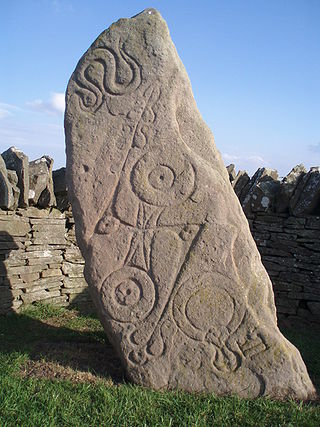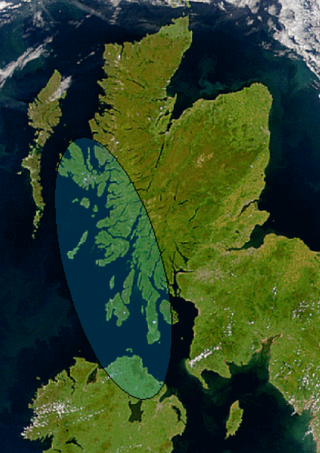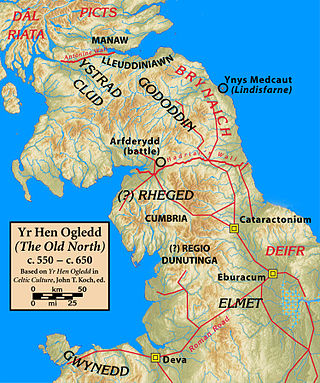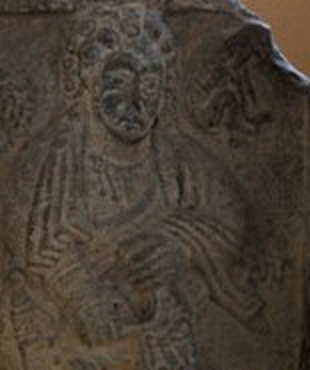Related Research Articles
Causantín mac Cináeda was a king of the Picts. He is often known as Constantine I in reference to his place in modern lists of Scottish monarchs, but contemporary sources described Causantín only as a Pictish king. A son of Cináed mac Ailpín, he succeeded his uncle Domnall mac Ailpín as Pictish king following the latter's death on 13 April 862. It is likely that Causantín's reign witnessed increased activity by Vikings, based in Ireland, Northumbria and northern Britain. He died fighting one such invasion.

The Picts were a group of peoples who lived in Britain north of the Forth–Clyde isthmus in the Pre-Viking, Early Middle Ages. Where they lived and details of their culture can be inferred from early medieval texts and Pictish stones. The term Picti appears in written records as an exonym from the late third century AD, but was adopted as an endonym in the late seventh century during the Verturian hegemony. This lasted around 160 years until the succession of the Alpínid dynasty, when the Pictish kingdom merged with that of Dál Riata to form the Kingdom of Alba. The concept of "Pictish kingship" continued for a few decades until it was abandoned entirely as a contemporary signifier during the reign of Caustantín mac Áeda.

Dál Riata or Dál Riada was a Gaelic kingdom that encompassed the western seaboard of Scotland and north-eastern Ireland, on each side of the North Channel. At its height in the 6th and 7th centuries, it covered what is now Argyll in Scotland and part of County Antrim in Northern Ireland. After a period of expansion, Dál Riata eventually became associated with the Gaelic Kingdom of Alba.

The Gododdin were a Brittonic people of north-eastern Britannia, the area known as the Hen Ogledd or Old North, in the sub-Roman period. Descendants of the Votadini, they are best known as the subject of the 6th-century Welsh poem Y Gododdin, which memorialises the Battle of Catraeth and is attributed to Aneirin.

Óengus son of Fergus was king of the Picts from 732 until his death in 761. His reign can be reconstructed in some detail from a variety of sources. The unprecedented territorial gains he made from coast to coast, and the legacy he left, mean Óengus can be considered the first king of what would become Scotland.
Loarn mac Eirc was a possible king of Dál Riata who may have lived in the 5th century. He was buried on Iona. Loarn's main significance is as the eponymous ancestor of Cenél Loairn, a kindred whose name is preserved in Lorne.
Conall mac Taidg was a king of the Picts from 785 until 789. Very little is recorded of Conall. He is mentioned twice by the Irish annals, the most reliable source for the history of northern Britain in the years around 800. He also appears in later king lists.
The Battle of Corbridge took place on the banks of the River Tyne near the village of Corbridge in Northumberland in the year 918.

The High Middle Ages of Scotland encompass Scotland in the era between the death of Domnall II in 900 AD and the death of King Alexander III in 1286, which was an indirect cause of the Wars of Scottish Independence.
Arthgal ap Dyfnwal was a ninth-century king of Alt Clut. He descended from a long line of rulers of the British Kingdom of Alt Clut. Either he or his father, Dyfnwal ap Rhydderch, King of Alt Clut, may have reigned when the Britons are recorded to have burned the Pictish ecclesiastical site of Dunblane in 849.
Dyfnwal was King of Strathclyde. Although his parentage is unknown, he was probably a member of the Cumbrian dynasty that is recorded to have ruled the Kingdom of Strathclyde immediately before him. Dyfnwal is attested by only one source, a mediaeval chronicle that places his death between the years 908 and 915.
The Cenél Loairn, the descendants of Loarn mac Eirc, controlled parts of northern Argyll around the Firth of Lorne, most probably centred in Lorne but perhaps including the islands of Mull and Colonsay, Morvern and Ardnamurchan. The boundary to the east was the Druim Alban mountain ridge that separated Dál Riata from Pictland. The chief places of the kingdom appear to have been at Dun Ollaigh, near Oban and Dunadd near Crinan. The chief religious site may have been on Lismore, later the seat of the High Medieval bishop of Argyll.
Amlaíb mac Illuilb was a tenth-century King of Alba. He was one of three sons of Illulb mac Custantín, King of Alba, and a member of Clann Áeda meic Cináeda, a branch of the Alpínid dynasty. Amlaíb's paternal grandfather possessed strong connections with the Scandinavian dynasty of Dublin, and there is evidence to suggest that Illulb and Amlaíb bore names of Old Norse origin. If Amlaíb's name indeed represents a Gaelicised Scandinavian name, it could indicate that his mother was a member of the Uí Ímair, and possibly a granddaughter of Amlaíb Cúarán or Amlaíb mac Gofraid.
Caittil Find was the leader of a contingent of Norse-Gaels, recorded as being defeated in battle in 857 CE. Some historians have considered him to be identical to Ketill Flatnose, a prominent Norse sea-king who had strong associations with the Hebrides of Scotland and Olaf the White. This view is however not shared by all.

Scotland was divided into a series of kingdoms in the early Middle Ages, i.e. between the end of Roman authority in southern and central Britain from around 400 CE and the rise of the kingdom of Alba in 900 CE. Of these, the four most important to emerge were the Picts, the Gaels of Dál Riata, the Britons of Alt Clut, and the Anglian kingdom of Bernicia. After the arrival of the Vikings in the late 8th century, Scandinavian rulers and colonies were established on the islands and along parts of the coasts. In the 9th century, the House of Alpin combined the lands of the Scots and Picts to form a single kingdom which constituted the basis of the Kingdom of Scotland.

Scandinavian Scotland was the period from the 8th to the 15th centuries during which Vikings and Norse settlers, mainly Norwegians and to a lesser extent other Scandinavians, and their descendants colonised parts of what is now the periphery of modern Scotland. Viking influence in the area commenced in the late 8th century, and hostility between the Scandinavian earls of Orkney and the emerging thalassocracy of the Kingdom of the Isles, the rulers of Ireland, Dál Riata and Alba, and intervention by the crown of Norway were recurring themes.

Government in medieval Scotland, includes all forms of politics and administration of the minor kingdoms that emerged after the departure of the Romans from central and southern Britain in the fifth century, through the development and growth of the combined Scottish and Pictish kingdom of Alba into the kingdom of Scotland, until the adoption of the reforms of the Renaissance in the fifteenth century.

The geography of Scotland in the Middle Ages covers all aspects of the land that is now Scotland, including physical and human, between the departure of the Romans in the early fifth century from what are now the southern borders of the country, to the adoption of the major aspects of the Renaissance in the early sixteenth century. Scotland was defined by its physical geography, with its long coastline of inlets, islands and inland lochs, high proportion of land over 60 metres above sea level and heavy rainfall. It is divided between the Highlands and Islands and Lowland regions, which were subdivided by geological features including fault lines, mountains, hills, bogs and marshes. This made communications by land problematic and raised difficulties for political unification, but also for invading armies.

Gregory Duncan Woolf, is a British ancient historian, archaeologist, and academic. He specialises in the late Iron Age and the Roman Empire. Since July 2021, he has been Ronald J. Mellor Chair of Ancient History at University of California, Los Angeles. He previously taught at the University of Leicester and the University of Oxford, and was then Professor of Ancient History at the University of St Andrews from 1998 to 2014. From 2015 to 2021, he was the Director of the Institute of Classical Studies, and Professor of Classics at the University of London.
Sally M. Foster is a Scottish archaeologist and senior lecturer at the University of Stirling. She specialises in the archaeology of Scotland, particularly the Picts and their neighbours in the early medieval period.
References
- 1 2 3 "Dr Alex Woolf". School of History. University of St Andrews. Retrieved 30 September 2017.
- 1 2 Jack Davey, 'InFocus: Dr Alex Woolf', The Saint (12 October 2023).
- 1 2 "Alex Woolf | University of St Andrews - Academia.edu". st-andrews.academia.edu. Retrieved 16 October 2023.
- 1 2 "Spotlight on Alex Woolf". St Andrews School of History. University of St Andrews. 1 February 2013. Retrieved 30 September 2017.